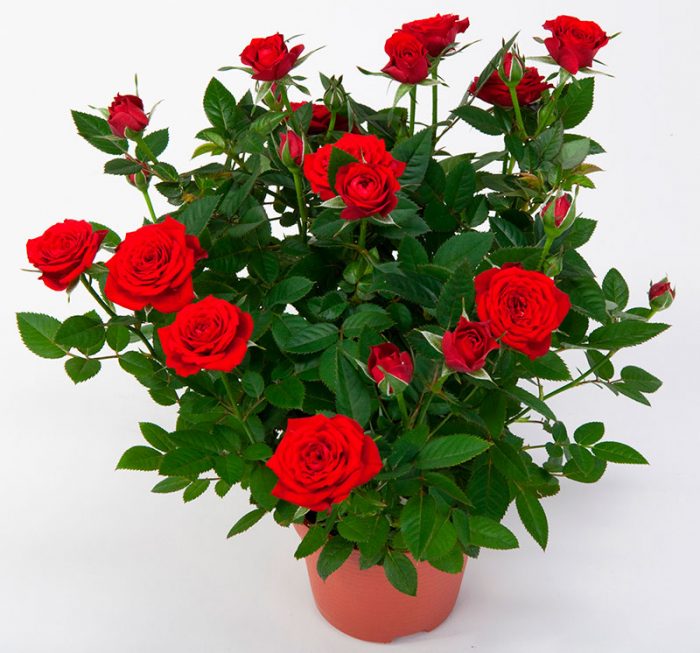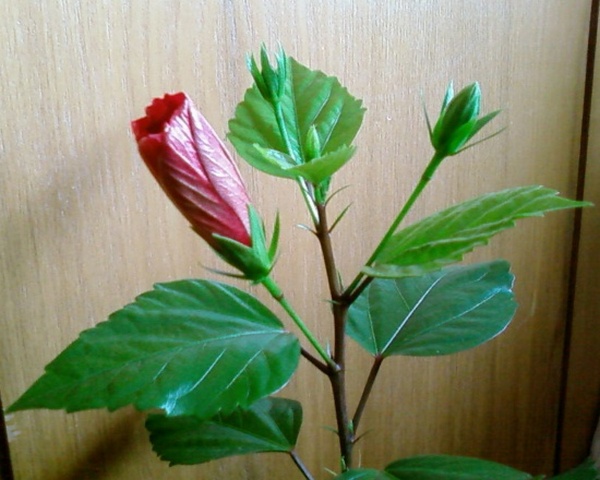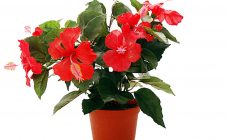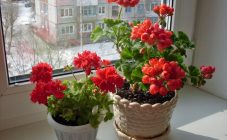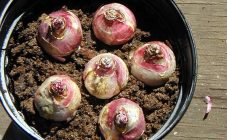Chinese rose home care when following the rules and recommendations is simple and not laborious. The plant originally grew in Asia Minor, India and China. Oriental people believe that the flower has some kind of magical power. It can have a beneficial effect on the human biofield. The girls themselves use the flowers to decorate their hair.
Description of the rose
The Chinese rose (hibiscus) is a shrub that resembles a small tree. This culture is also called the “flower of love”.
The flowers are large and come in different colors. The pistil and stamens have grown together and stick out from the petals with a point. The bush itself is woody and resembles a tree. The leaf plates are very beautiful, green and glossy. The culture is often used for decorative purposes. In nature, the rose reaches 4 meters. At home, these figures are lower. Indoors, the rose can reach 1.5 meters. They plant it in tubs and put it on the floor, since the root system and the tree itself require a lot of space.
The culture is spectacular and popular; it is planted in administrative buildings, in residential buildings, apartments. Hibiscus lives up to twenty years. It is unpretentious in leaving. For breeding, tree-like forms are used, alone, and in composition, as well as in a winter garden. The tub is placed on the floor or on the windowsill in a spacious, bright room, hall.
Hibiscus is a very sprawling bush. But it lends itself to crown formation. Some varieties are grown as standard trees. The height in the room is up to one and a half meters, in nature - up to 4.5 m.
The bush prefers a bright place, but without the scorching sun rays. In summer, the tree is taken out onto the balcony or veranda.
Also, the bush begins to shed everything due to lack of nutrients, poor watering, low air temperature. In the spring, hibiscus is transplanted and fertilized, placed in a warm place.
With growth, yellow leaves appear, the lower ones fall off. This disease is called chlorosis - a lack of nitrogen and iron. You need to defend the water or add iron chelate. When the air in the room is dry, the rose needs to be sprayed more.
Agrotechnics
The optimum temperature is 20-25 degrees. The rose does not tolerate sudden fluctuations. In winter, 12-18 degrees are favorable.
In the spring and summer, it is necessary to water more regularly, with warm and soft water. The earthy ball must be completely moistened. The next watering is after the topsoil has dried. After an hour, the soil can be loosened.
During the dormant period and in winter, the flower is moderately moisturized. To avoid decaying roots, you need to pour water from the pan.
The rose requires moderate moisture. It is periodically sprayed. In hot weather it is necessary to moisturize especially regularly, as well as in winter with dry air. The flower is sprayed under the shower.
The flower must be fertilized regularly and in small quantities. Mineral supplements are alternated with organic ones (mullein 1 part - for 10 hours of water). For budding, fertilize with phosphorus salts. The main thing is not to overdo it so that growth is not suppressed. It is necessary to use nitrates in moderation - instead of flowers, foliage will grow.
Special complex feeding:
- Rainbow;
- Ideal and others.
The rose is fed from April to August. The frequency of fertilization is determined empirically by observing the growth of the bush. In winter, they feed once a month ½ of phosphorus and potassium. Before adding nutrients, the rose should be watered with clean water.
Pruning improves budding as buds form on young shoots. All procedures are done in the spring before transplantation. All nondescript and dried shoots are cut off. Healthy branches are shortened by 1/2 or 1/3.
The hibiscus will grow again after a short time. In July, the pruning is repeated. The rose blooms even in October and November.
In the spring, before the start of growth, pinch the bush and young shoots. During the procedure, it is necessary to give a certain shape to the rose. No need to feel sorry for sick and undergrown branches. It is necessary to remove vertical shoots competing with the trunk. Branches growing inward and thickening the bush are also removed.
Crown shaping - pruning to your liking. Processing in the form of a standard tree looks beautiful. Side branches are constantly removed until the bush grows to the required height. Next, the top is cut off and 6 lateral shoots are allowed to grow to form bulk.
Reproduction:
- Seeds;
- Layers;
- Dividing the bushes;
- Vaccination;
- Rooting of green stem cuttings.
The last method is the most common. Cuttings are cut all year round, but the most suitable time is spring and summer. Cuttings are cut to 10 centimeters (3 internodes are left) and rooted in water or soil. The temperature should be 21 degrees.
Hibiscus takes root in all conditions, but most quickly in a wet mixture of sand and peat. A glass jar or a cut-off PE bottle is placed on top, creating the effect of a greenhouse. The leaf blades are cut in half for better rooting. If the rose has begun, it begins to release buds in a year.
The container for planting is selected spacious. In acceptable conditions, the rose grows rapidly. When transplanting a flower, this must be taken into account. In cramped containers, the rose grows slowly, but it actively releases buds.
Hibiscus loves well-lit windows. The east and west sides are suitable. In the south, you will need to shade. Already from March, the rose buds until autumn. Cover from the scorching rays of summer.
Rosan is shade-tolerant, many manage to grow it on the north window, but it buds less often here.
The transplant is carried out before the flowers bloom (March-April). A young rose is moved once a year, an adult only after two. For large trees, it is recommended to replace the top layer of soil in the tub with a nutrient composition. Pruning is carried out at the same time. Cuttings can be rooted. A month after moving the rose, top dressing is carried out.
Nutrient soil is well suited for planting, the flower does not tolerate the lime substrate well.
Ground mixes for hibiscus:
- 4 hours sod land, 2 hours - leaf, 4 hours - humus, 1 hour - sand;
- 2 hours sod land, 1 hour - humus, 1 hour - peat, ¼ part of bone meal and sand;
- all components in 1 part: turf, leafy earth, humus, peat, sand;
- 2 hours - turf, 1 hour - humus and 1 hour - peat land, 1 hour - sand and add pieces of charcoal;
- 2 hours - fertile garden soil, 1 hour - peat and 1 hour - sand.
For large tubular specimens, heavy soil is used. The rose grows well on peat soil.
The hibiscus needs drainage to keep the water from stagnating. Mulching is done, so the soil better maintains an optimal moisture level.
The rest period is October-February. Prepare the flower: stop fertilizing and reduce watering. The rose is transferred to a room with a temperature of 12-18 degrees.Under such conditions, flower buds begin to form. Do not place hibiscus next to heating appliances. At high temperatures and low lighting, leaves may fall off. Moisturize moderately.
Abundant and prolonged budding. The period lasts from April to October. After a day, the flower withers, then new buds bloom again. Hibiscus is a hardy crop that can grow in the most inappropriate conditions. It can withstand drafts, cold, darkness, and tolerates watering errors.
For full blooming flowers you need:
- Place the rose in a bright place, especially in winter.
- Apply nitrogen mineral fertilizing regularly.
- Prune annually to stimulate budding.
Subject to all the rules, hibiscus regularly releases buds.
Home care in a pot
Home flower tree rose how to care? Growing hibiscus is easy. Even a beginner can cope with the cultivation of a bush indoors.
It is necessary to maintain an optimal temperature of 19-23 degrees. Humidity should be around 60 percent. You also need to spray the bush regularly.
Why isn't hibiscus blooming in the room? This means that the temperature is either higher or lower than normal.
The place in the apartment is chosen from the south, south-east or south-west side. Varieties with brownish flowers can tolerate partial shade.
Secrets of experienced florists
The rose is unpretentious and very beautiful, but there are some nuances of caring for a hibiscus flower at home:
- Regular watering is required;
- For budding, you need a lot of light and properly cut;
- Soak the seeds when planting. So shoots will appear faster. The seeds are placed in a glass of water and placed next to the heater.
- It is necessary to feed in the evening or in cloudy weather. Water the flower before the procedure. Do not apply top dressing during the rest period and immediately after transplantation.
- After buying the roses, you need to immediately transplant, as usually there is bad soil in the store container. There are added bud growth stimulants that inhibit the development of a tree.
- Hibiscus does not like a sudden change in climate. If he has released the buds, then because of this, he may shed them. It is better to try to bring the flower to the place of budding in advance.
- Bringing the rose out of dormancy, you need to provide: watering, feeding, light, warmth, otherwise it will shed the buds.
- Do not overfeed with nitrogen - there will be excess foliage.
- In autumn and winter, the flower is moved to rest.
- Before waking up, you need to do pruning.
Even a beginner will be able to grow a Chinese rose at home, subject to the rules of agricultural technology described above.
